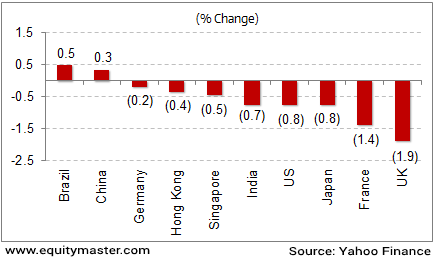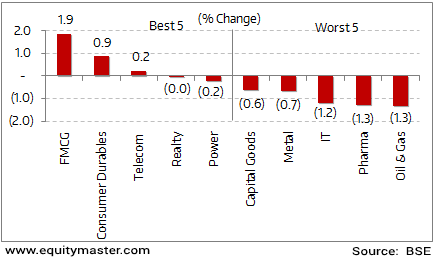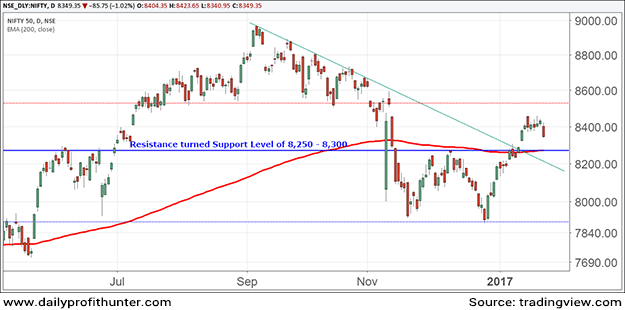India's Third Giant Leap
This Could be One of the Biggest Opportunities for Investors
- Home
- Todays Market
- Indian Stock Market News January 20, 2017
Global Markets Continues to be Volatile Fri, 20 Jan RoundUp
Global markets ended the week on a dull note with most of the markets ending flat or in the negative territory. Brazil's and China's indices were the only ones which ended the week on a positive note, with gains of 0.5% and 0.3% respectively.
Britain's FTSE emerged as the biggest loser with a 1.9% fall over the week, amid concerns over PM Theresa May's Brexit speech. Investors remained wary as the British parliament pledged that it would vote on any Brexit deal and welcomed clarity over the government's plans for leaving the EU.
United Kingdom Prime Minister Theresa May said Britain will quit the EU single market when it leaves the European Union (EU).
Among developed economies, all European indices reported a dip, amid Brexit woes. US markets too, were marginally down by 0.8% amid expectations from President Elect Donald Trump, who is set to formally take charge as President from 20 January.
Back home, the BSE-Sensex ended in red and was down 0.7%. The week started on a dull note with some positive streaks over the week amid quarterly result updates. The positive momentum was lost however amid weak results from
The earnings season continued with Axis bank reporting less than expected results led by an increase in provisions and NPAs. Yes Bank reported satisfactory results and its shares witnessed buying interest.
Key World Markets During the Week

On the sectoral indices front, FMCG and telecom stocks led the gainers this week. On the other hand, stocks from pharma, IT, and metal sectors witnessed maximum selling pressure.
BSE Indices During the Week

Now let us discuss some key economic and industry developments during the week gone by
India received US$ 1.77 billion foreign direct investment (FDI) in non-conventional energy sector from April 2014 to September 2016.
As per the data, most the bigger investments have come from Mauritius, Malaysia, Philippines, Singapore, Japan, Germany, Spain, US and Seychelles. Further, the renewable energy sector has witnessed the highest-ever solar power and wind power capacity addition since April 2014.
One must note that, the government has revised its target of renewable energy capacity to 175 Gigawatt by end of 2022, making it the largest expansion plan in the world, providing plenty of opportunities for investors.
Over the past two years, foreign direct investment in India's electricity sector was US$1.32 billion. According to the country's power minister, more than US$250 billion will be invested in renewable power generation and transmission in India over the next five years, a figure that could reach US$1 trillion by 2030.
Apart from FPIs, the upcoming budget is said to bring cheer to both individuals and corporate taxpayers. This comes as the government looks to lift sentiment in the wake of demonetisation.
On the cards is a revamp of the income-tax framework for individuals and a reduction in the corporate tax rate to encourage companies to invest.
For individual tax-payers, there is a proposal to widen the Rs 2.5-5 lakh slab and tax it at a lower rate. If this happens, there will be a revival in demand which had been hit by demonetisation. An increase in take-home pay will spur overall consumption and, in turn, benefit the economy.
On the corporate tax side, the government aims to bring down the tax rate to 25% over four years beginning this year. A reduction in rates here will mean rise in private investments.
As of now, our corporate tax rate stands at almost 35%, which is the second highest in the world.
The International Monetary Fund (IMF) lowered India's growth forecast for FY17 by a full percentage point to 6.6%. This comes as the IMF projects deceleration in India's GDP growth on the back of disruption caused by the government's demonetisation move. The earlier estimate of growth has been 7.6%. IMF also expects India's growth to pick up at a slower pace in 2017-18, at 7.2%, against its earlier estimate of 7.6%.
One must note that the government of India has pitched for a 7.1% GDP growth in FY17. This estimate is still below the 7.6% growth recorded in FY16.
We believe, FY17 GDP growth could be significantly lower than 7.1%. Growth in India has slowed down in the recent months. This was seen on the back of demonetisation. The government has not factored in the negative impact of demonetisation in the above 7.1% GDP estimate for FY17. This we say because the government did not have the data to do so.
As per the latest United Nations labour report, India's unemployment level is set to rise through 2017 and 2018. The report pegs the unemployment rate at 3.4% in 2017-18, similar to current levels.
India has been struggling with jobless economic growth since over a decade. According to the latest Economic Survey, annual employment growth in India was only 0.5% during the period 2004-12, while labour force growth was 2.9%. The coming months will be crucial to evaluate the full impact of the demonetisation drive on the employment front.
The goods and services tax (GST) is set to be rolled out from 1 July 2017 after the centre and the states struck a consensus on the contentious issue of sharing of administrative powers. The decision was finalized during the ninth meeting of the GST Council.
At the end of the meeting both sides agreed to work towards meeting the new deadline and sharing administrative control over small and big taxpayers in a fixed ratio.
The road is now clear for the central government to table all the associated bills relating to the GST in the upcoming budget session of the parliament, starting from 31 January.
After 1 July, when the GST rolls out, it will bring with it host of regulations to enable transparency in the tax regime. There will be an estimated 8 million taxpayers under GST.
As per the agreement arrived between the centre and the states, small taxpayers with an annual revenue of less than Rs 15 million under GST will be divided between the states and the centre in the proportion of 90:10 for the purpose of scrutiny and audit. This will be done randomly.
Movers and Shakers During the Week
| Company | 13-Jan-17 | 20-Jan-17 | Change | 52-wk High/Low |
|---|---|---|---|---|
| Top Gainers During the Week (BSE Group A) | ||||
| GAIL | 442 | 461.4 | 4.4% | 465/291 |
| ITC Ltd | 244.3 | 255 | 4.4% | 266/179 |
| HUL | 825.75 | 858.2 | 3.9% | 465/291 |
| Asian Paints | 932.75 | 964.15 | 3.4% | 1,230/827 |
| Tata Steel | 447.75 | 455.4 | 1.7% | 470/211 |
| Top Losers During the Week (BSE Group A) | ||||
| Infosys Ltd | 1,000.05 | 946 | -5.4% | 1,278/900 |
| Reliance Ind | 1,083.15 | 1,026 | -5.3% | 1,129/889 |
| Adani Ports & SEZ | 293.15 | 284.6 | -2.9% | 317/170 |
| Coal India | 312.60 | 304.4 | -2.6% | 350/272 |
| L&T | 1,449.1 | 1,412 | -2.6% | 1,615/1,017 |
Some of the key corporate developments in the week gone by
Oil and Natural Gas Corporation (ONGC) plans to increase output at its Vashishta gas field from 1.1 million standard cubic meters per day (msmcd) currently to 5 msmcd by July this year. Vashishta and S1 gas fields, located in the Krishna- Godavari (KG) Offshore Basin off the east coast of India, began operations in September last year.
One must note that, ONGC is currently developing Vashishta and S1 gas fields in KG basin under a deep-water development project with an investment of US$751.65 million. The Vashishta field is estimated to produce 9.56 billion cubic metres (bcm) over a period of nine years
Similarly, the S1 field is located undersea between 250 and 600 meters. It is expected to deliver an output of 6.22 bcm over a period of eight years. While the Vashishta field is a free gas field with estimated reserves of 12.92 bcm, the S1 field lies to the east of G-1 field and is a free gas field with estimated reserves of 10.37 bcm.
Reportedly, Vashishta is the first field in the country to get the premium price of gas
Hindustan Zinc has achieved the highest ever mined metal production during the third quarter ended December 31, 2016, up 44% from previous quarter and 21% YoY.
The sequential increase was on account of higher volumes from Rampura Agucha open cast mine in accordance with mine plan and the YoY increase was driven by higher volumes from Rampura Agucha underground and open cast mines.
State Bank of India concluded the issue of US$500 million fixed rate Senior Unsecured Notes with maturity of five years at a coupon of 3.25% payable semi-annually under Regulation-S. The bonds will be issued through the Bank's London branch as of January 24, 2017, and will be listed on the Singapore Stock Exchange.
Although the bank is flush with funds following demonetisation, the dollar denominated borrowing will enable the bank meet funding requirement of its international operations, which are spread across 37 countries.
The transaction saw strong interest from investors across geographies with an order book in excess of US$1.5 billion across 170 accounts. According to SBI's Chairman Arundhati Bhattacharya the response to the bond offering reflected the strong perception of the bank's credit by the international investor community.
The bond is rated Baa3 by Moody's. S&P, on the other hand, has issued a 'BBB-' long-term issue rating.
Cairn India received an approval for undertaking drilling works of 64 exploratory and appraisal wells in KG-OSN-2009/3 block in KG basin at Prakasam and Guntur districts of Andhra Pradesh. A committee under the Ministry of Environment, Forests and Climate Change has given a green signal to the company for the same.
The Expert Appraisal Committee (EAC) while according to environmental clearance set a few conditions along with other specific and general environmental conditions relevant to the project proposal.
The company has proposed for drilling of 55 exploratory and 11 appraisal wells in KG-OSN-2009/3 block in Offshore KG Basin. The offshore block in the Bay of Bengal along the coast of Andhra Pradesh is spread over an area of about 1988 km.
The steel Ministry clarified that the government will not go in for any "distress" sale of three Steel Authority of India (SAIL)'s subsidiaries. The Salem Steel Plant, Visvesvaraya Iron and Steel and Chandrapur Ferro-Alloy will see the government look for a management that can turn these units around.
Earlier, the government had in-principle approved strategic disinvestment of SAIL's Bhadrawati, Salem and Durgapur (alloy steel plants).
Considering disinvestment strategy, the government's disinvestment target has become all the more difficult to achieve
Reportedly, there is no proposal of strategic disinvestment for more units of SAIL. This announcement of strategic disinvestment means a minimum of 51%. So, it all depends on efficiency. It is under very initial stages, the reports noted.
Cadila Healthcare, and its subsidiary Zydus Pharmaceuticals (USA) Inc., have finalized an agreement with Kowa Pharmaceuticals America, Inc. and Nissan Chemical Industries, to settle all outstanding patent litigation related to Livalo (pitavastatin calcium) tablets.
Reportedly, Kowa and Nissan have granted licence to market Zydus' generic version of Livalo, beginning on May 2, 2023, or earlier under certain circumstances. Livalo tablets are indicated as an adjunctive therapy to diet to reduce elevated total cholesterol.
Recently, Cadila had also settled all outstanding patent litigation related to Qudexy XR (topiramate) extended-release capsules with US-based Upsher-Smith Laboratories, Inc. Qudexy XR extended-release capsules are used to treat certain kind of seizures in adults.
Innovators in the pharmaceutical industry largely make use of patents. They make heavy use of patents whenever they create a new drug. In one of our recent editions of The Equitymaster Digest, we wrote everything you need to know about patented drugs, its advantages and its implications.
HDFC has cut its retail prime lending rate (RPLR) by 15 basis points to 16.15% in a move that will benefit existing customers. The reduction in the RPLR will also be applicable on loans to non-resident Indians (NRIs)/ PIO card holders.
One of the biggest contributors to India's banking loan book growth is housing loans. As per RBI, as of 30th October 2016, it contributed around 54% to the total retail loan book of the banking system.
Now since the contribution of the housing loans to total retail loan portfolio is around 54%, the overall growth of the banking credit largely depends on the growth of the housing sector.
In another development, Axis Bank Ltd's fiscal third quarter net profit fell 73.3% on-year to Rs 5.79 billion, amid rising NPAs and falling margins.
Axis Bank's gross NPAs also expanded higher than expected to 5.22% in Oct-Dec from 4.17% in the preceding quarter, rising by more than a full percentage point. The company's net NPAs in the fiscal third quarter rose to 2.18% from 2.02% in the previous quarter.
Idea Cellular Ltd is in talks with Vodafone India for a potential merger. The merger, if it happens, will be complementary to their operational strengths and will also pave the way for a backdoor listing of its business without going through an IPO process.
Vodafone is reportedly looking for an alliance with either Reliance Jio or Idea. According to reports combined entity of Vodafone and Idea will have a 43% revenue market share versus the 33% of Bharti Airtel currently and 13% for Reliance Jio by FY19 consolidated.
With their 3G network across India and highest 4G spectrum of 1800MHz, the combined entity will be a strong competitor in the data market.
The merger, however, will not be without regulatory hurdles. The rules mandate that subscriber and revenue market shares have to be below the 50% mark in such cases, while spectrum holdings have to be below specified caps.
And here's an update from our friends at Daily Profit Hunter...
It was a dull week for the Indian markets. Last week, the Nifty-50 index broke out of an important resistance (now support) of 8,250-8,300 levels and rallied strongly to make a high of Rs 8,461. But the index did not sustain up there for long. For the week, the Nifty-50 Index opened on a flat note and traded in a very tight range near 8,400 levels till Thursday. On Friday, the index opened gap down and slipped sharply to close 1% negative. The Nifty-50 index finished the week 51 points down. It seems that the index is aiming to re-test its support levels of 8,250-8,300.
Nifty-50 Index Traded Dull for the Week

For information on how to pick stocks that have the potential to deliver big returns, download our special report now!
Read the latest Market Commentary


Equitymaster requests your view! Post a comment on "Global Markets Continues to be Volatile". Click here!
Comments are moderated by Equitymaster, in accordance with the Terms of Use, and may not appear
on this article until they have been reviewed and deemed appropriate for posting.
In the meantime, you may want to share this article with your friends!